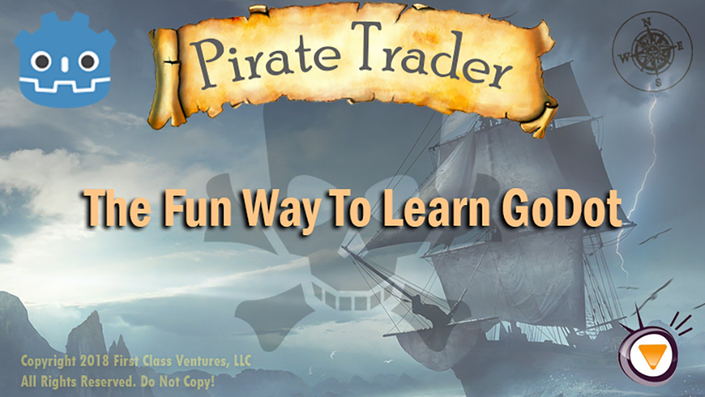
Learn Godot Making a Fun Pirate Trading Game
For game designers & developers who want to learn game prototyping and design patterns
THIS COURSE GETS YOU FROM BEGINNER TO ADVANCED AS FAST AS POSSIBLE
This was designed to be a fast based course. Instead of bumping up the hours of the course, this course is designed to get you into advanced topics quickly. We start out with very beginning topics so even a new programmer can use this course, but we waste no time getting into advanced Godot topics. I'm aware that many students search for courses with lots of hours in the hopes of equating it to more material. You will often find those courses will spend exhaustive time on basics and editor tools that are available in the community or on YouTube.
THIS COURSE FOCUSES ON GAME ARCHITECTURE AND DESIGN
While we begin with simple programming concepts the course continually refactors and improves the game architecture as new functionality is added. Learn how to create a sophisticated game architecture that involves products, cities, prices that can change by city, buying/selling, and of course a prototype of a pirate battle. Learn to use signals decouple objects and refine your game design.
LEARN PROTOTYPING AND REFACTORING SKILLS
This course follows the process you would use in real world iterative game design. We build simple prototypes that we can get up and running quickly. Then as we better define our gameplay we refactor and implement improved game architecture so we can add more features. The result is a course that will help you with any game you wish to build out. Finding the right balance between rapid progress and prototyping and creating a solid game architecture you can build on is a key to successful game design.
FOR STUDENTS THAT DON'T WANT TO TAKE A 30 HOUR COURSE TO LEARN ADVANCED TOPICS
There are a lot of great courses on here but long 30 hour courses are not for everyone. Instead of lectures that spend a lot of time in theory, explaining the course itself, or exhaustively covering basic features you will find in other courses... this course just jumps in and starts building a fun Pirate Trading Game like Taipan. We start with very simple features like variables, creating functions, and using basic signals. But we quickly move right into the meat & potatoes of what it takes to make a solid game architecture.
LEARN TO SEPARATE YOUR DATA OBJECTS FROM USER INTERFACE - And when it may not be worth the time
This course takes a practical approach to building game prototypes. That said, there is a time when you must refine your game architecture and work to improve the design patterns you are using to build up your game. In this course we learn how to use signals, static methods, and dependency injection techniques to encapsulate your data making it easier to create far more robust game architectures. We also explore when it useful to break some of the rules in the interest of brevity and creating a working prototype.
This course teaches you the skills you need so you can build games in a way that suits your own development style.
CONSIDER MY IDLE TYCOON COURSE IF YOU ARE NEW TO GAME ARCHITECTURE AND DESIGN
My other Godot course, Idle Business Tycoon course has a bit more simple game design and is likely more suitable to absolute beginners.
See the power of Godot first hand
You will see quickly why so many game developers are looking to Godot for their indie game projects. We create the project, the scene and begin scripting in the very first lecture! By the second lecture we are using lists to manage our cities. By the third lecture we are already using objects and building up a complex game architecture.
The engine is particularly well suited for games that are interface intensive. There are many user controls and they are very easy to script.
If you have ever wanted to learn Godot and enjoy pirate trading games like Taipan you are in luck. This course walks you through the design of making a Pirate Trading Game prototype from scratch. Step-by-Step.
Your Instructor

Greg Moss started working with personal computers at 12 years old. At age 15, he wrote his first paid business application, a loan management application for First American Acceptance Corporation. A few months later Greg developed a statistical application to process surveys for John A Logan College. Now more than 30 years later, Greg has produced hundreds of commercial applications and training courses, and has been involved in numerous enterprise application projects.
In addition to completing degrees in Business Administration and Information Systems Design, Greg is a Certified Information Systems Auditor, a Six Sigma Black Belt, and holds an Information Assurance Certification from Carnegie Mellon University. In addition to his successful consulting practice, Greg has worked in positions as a Chief Information Officer (CIO), Chief Executive Officer (CEO), and excels in delivering technology-enabled growth to companies. He is an experienced digital marketer and focuses on real-world results and solutions.
Greg is the founder of First Class Ventures, LLC and OdooClass.com. Over the past 8 years Greg has produced over 200 video courses covering business application development and game design.
Greg is the author of Working with Odoo, Working with Odoo 10, Working with Odoo 11, Working with Odoo 12, and Learn Odoo.
Course Curriculum
-
StartFast Start: Create Project Scene and your First Godot Script (14:31)
-
StartUse a List for Cities and use Buttons and Signals to Leave Port and Set Sail (11:19)
-
StartExamine Using Dictionaries to Represent our Products (6:30)
-
StartRefactor our Game to use Objects to Represent Cities (8:19)
-
StartCreate Product Objects and Extend the Game Design (11:09)
-
StartCreate CityProduct Data Structures to Manage Product Pricing by City (11:32)
-
StartCreate a ProductPanel Object to Visually Represent the Products in the City (17:04)
-
StartReview of the Current Game Architecture and Prototype (5:52)
-
StartRefactoring Our Product and City Data to Use Dictionaries (13:56)
-
StartUse Custom Signals to Create a Better Game Architecture (18:52)
-
StartUse Static Methods to Further Improve our Game Architecture (10:09)
-
StartPerform a Top Down Re-factor of the Game Code Using What We Have Learned So Far (8:36)
-
StartBegin Implementing the Buying Process into the Game (11:09)
-
StartFinish Implementing our Buy Products Method (10:12)
-
StartImplementing the Sell Mechanism for our Game (5:01)
-
StartCreating a Simple Pirate Battle for our Game (9:42)
-
StartAdding Player Ship Health and Checking for the Player Ship to Sink (13:30)
-
StartImprove the Game Appearance, Import Custom Fonts & Create a Game Over Screen (19:49)

